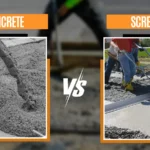So, you’ve chosen the ideal paving slabs for your new patio and opted to save some money by installing them yourself. While many homeowners consider hiring professionals for this task, doing it yourself can save significant costs and provide a sense of accomplishment.
Now, the challenge is determining the most suitable way to lay the paving flags that will work well for both you and your garden. Don’t be intimidated by this do-it-yourself task; instead, think about the positive impact of paving on your garden. The investment of time and effort in proper installation techniques pays off with a finished product. A product that requires minimal maintenance and remains functional for years to come.
Read More: How To Lay Floor Tiles On Concrete?
This Is Your Guide On How To Lay Paving Slabs On Concrete
Option 1: Installing Paving Slabs on a New Concrete Bed
Creating a new concrete bed for your paving slabs takes more time but gives you complete control over your patio placement. This method works best when you’re starting from scratch or when existing foundations are beyond repair. A properly prepared concrete bed provides the solid foundation needed for a long-lasting patio installation.
Tools and Materials You’ll Need:
- Measuring tape
- Wooden pegs
- String
- Shovel
- Spirit level
- Rake
- Garden roller/tamper
- MOT Type 1 sub-base
- Cement
- Sharp sand
- Wheelbarrow
Step-by-Step Preparation Process:
- Mark Your Area: Measure your intended paving area carefully and mark the boundaries using wooden pegs connected with string.
- Excavate the Site: Dig out the marked area to a depth of 105mm. Remove all vegetation, roots, and topsoil completely. Create a 1 in 80 gradient slope for effective water drainage.
- Level the Ground: Use a rake and spirit level to create an even surface. A garden roller or tamper can make this process easier.
- Add Sub-base Material: Fill the excavated area with 70mm of MOT Type 1 sub-base. Compact this material down to 50mm to create a solid, level foundation.
- Mix Your Concrete: Prepare your concrete mix in a wheelbarrow according to package instructions. For detailed guidance on proper mixing techniques, see our comprehensive guide on mixing mortar for paving.
- Apply the Concrete Layer: Spread a 30mm layer of concrete mix evenly over the compacted sub-base. Use your levelling tools to ensure a smooth, even surface with the correct gradient. Once levelled, you are ready for concrete slabs.
Read More: How Many Concrete Blocks On A Pallet?
Starting with Installing Paving Slabs on New Concrete
With the new domestic concrete bed ready, it’s time to start laying concrete pavers to form your patio. This stage requires quick work before the concrete sets. Working efficiently and methodically will get you professional-looking results.
Here are the eight tools and equipment you’ll need:
- Knee pads
- Thick gloves
- Your chosen pavers
- Rubber mallet
- Spirit level
- Tarpaulin
- Jointing compound
- Hard-bristled brush
Step-by-Step Installation Process:
- Safety First: Put on knee pads and thick gloves before starting. These protect you from both the wet concrete and the rough edges of the paving slabs.
- Place the First Slab: Position your first paving slab in a corner of your prepared area. Use the rubber mallet to tap it gently but firmly into the wet concrete. Check with your spirit level to ensure it sits perfectly flat and at the correct gradient for drainage.
- Add Subsequent Slabs: Position the next slab carefully, maintaining an 8-10mm gap between it and the first slab. This gap is crucial for the jointing compound later. Tap it down with the rubber mallet and check its level with your spirit level.
- Complete the Paving: Continue adding slabs in a methodical pattern, always maintaining consistent 8-10mm gaps between them. Regularly check that slabs are level both individually and in relation to adjacent slabs.
- Allow Setting Time: Once all slabs are in place, leave the installation untouched for 24-48 hours to allow the concrete to set properly. If rain is forecast, cover the entire area with tarpaulin to protect your work.
- Apply Jointing Compound: When the concrete has fully set, fill the 8-10mm gaps between slabs with the jointing compound. This binds the slabs together and prevents weed growth. Follow the manufacturer’s instructions for the best results.
- Clean and Finish: Use a hard-bristled brush to remove any excess jointing compound from the surface of your paving slabs. Sweep diagonally across the joints to avoid dislodging the fresh compound.
Read More: How To Get Paint Off Concrete?
Option 2: How To Lay Slabs Over Old Concrete
When laying a concrete slab over existing concrete, proper preparation is essential for a successful installation. Start by gathering all the necessary tools and materials for the project to maintain organisation during the work. Wear protective gloves to minimise messiness during the project, as it can get a bit dirty. This method is faster than creating a new concrete bed and works well when your existing concrete is in good condition.
- Inspect Your Slabs: Before applying any primer, check each paving slab for cracks or defects. Using damaged slabs can compromise the integrity of your finished patio.
- Clean the Slabs: Remove any dirt, dust, or debris from the back of each slab. A clean surface ensures better primer adhesion.
- Apply Primer: Using a brush or roller, apply a concrete bonding primer to the back of each paving slab. The primer creates a strong bond between the slab and the mortar bed. Allow the primer to become tacky as per the manufacturer’s instructions before proceeding.
Mixing Mortar
For a strong bond between existing concrete and new paving slabs:
- Gather Materials: You’ll need sharp sand, cement, clean water, a wheelbarrow, and a mixing tool.
- Safety First: Wear a dust mask, safety goggles, and waterproof gloves to protect yourself.
- Mix Properly: Combine four parts sand with one part cement, then add water (approximately one part) until you achieve a consistent, workable paste.
- Check Consistency: The mortar should hold its shape when pressed but remain workable.
Applying Mortar and Laying Slabs
- Apply Mortar: Spread a 30mm layer evenly where you’ll place your first slab.
- Position Slabs: Place each slab with 10mm gaps between them. Check levels with a spirit level.
- Secure in Place: Tap slabs firmly with a rubber mallet, working from the centre outward.
- Fill Gaps: Once all slabs are positioned, fill the gaps with a slightly wetter mortar mix.
- Finishing Touches: Allow 24-72 hours for curing, depending on weather conditions. Once cured, clean the surface with a soft brush and water.
Read More: How To Make A Concrete Base For Your Shed?
Ending Notes
Whether you’re learning how to pour a slab from scratch or simply laying paving slabs on an existing surface, both methods can produce excellent results when done correctly. Taking time to prepare properly and follow each step carefully will result in a professional-looking patio that you will feel proud of every time you look at it. Get these right, and you won’t have to worry about your patio for a long time!
To make sure you get the best quality domestic concrete for your project, contact Pro-Mix Concrete in London. We’ll be happy to get this task, of supplying the best possible concrete, off your hands so you can only focus on laying paving slabs on concrete.
Frequently Asked Questions
When laying slabs over existing concrete, applying a concrete bonding primer to the back of each slab is recommended. This creates a stronger bond between the slab and the mortar bed.
A recommended mortar mix ratio is four parts sharp sand to one part cement, with enough water (approximately one part) to create a workable consistency that holds its shape when pressed.
No, you should allow at least 24 hours for the installation to cure before walking on it. In colder or more humid conditions, extend this to 72 hours for complete curing.
Essential tools include measuring tape, spirit level, rubber mallet, trowel, shovel, rake, protective gear (gloves, knee pads, safety goggles), and for new concrete beds: wooden pegs, string, and a garden roller/tamper.
Author
- Dennis Broderick
- Dennis Broderick is the founder and owner of Pro-Mix Concrete Company, a trusted name in ready-mix concrete solutions across the UK. With over 20 years of hands-on experience in the construction and concrete industry, Dennis brings unmatched expertise, practical insights, and a commitment to quality on every project - from residential driveways to large-scale commercial developments.
Latest entries
BlogJuly 15, 2025Why Same-Day Concrete Delivery is Vital for Small Builders in London?
BlogJuly 10, 2025Concrete vs. Screed: Which is Best for Your Project?
BlogJuly 5, 20255 Mistakes to Avoid When Ordering Ready Mix Concrete in London
BlogJune 27, 2025How Same-Day Concrete Delivery Works in the UK?




